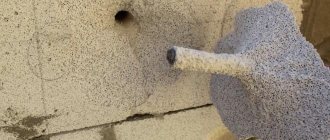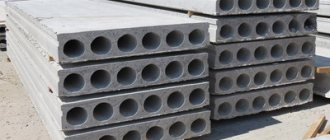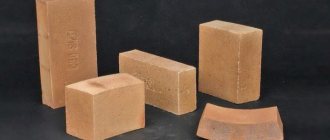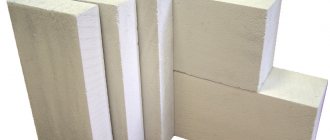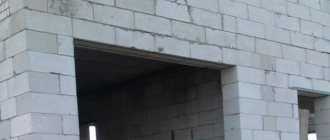Appearance of the expansion dowel
The dowel consists of non-expandable and spacer parts. It is the non-expandable part that prevents damage to the plaster coating and destruction of the surface itself inside the hole (for example, a wall when fastening to a wall). Thanks to this part, the screw or nail itself easily fits into the hole and securely fixes the mount.
The dowel has a relief shape with two tendrils and one cut or four along the entire length. This shape and design, on the one hand, does not allow the bolt to rotate inside the concrete, and the antennae allow it to additionally catch inside the hole. This ensures better fixation of the product.
As a rule, its length is 25-100mm with a diameter of 5-14mm. Able to withstand long-term loads of up to 200kg.
The use of such a dowel is supported by the fact that environmental materials are used in its production. And the property of resistance to acid and alkali increases the service life and expands the scope of application.
- Rigidity and hardness, as well as resistance to high temperatures, make the dowel a unique and beneficial means of fastening (up to 80 degrees).
- And a separate advantage is worth noting the resistance of spacer dowels to corrosion, which makes it practically durable in use and reduces the cost, and therefore the selling price of the finished product.
- The only serious disadvantage is low resistance to frost and some fragility. Manufacturers recommend using this type of fastener indoors to preserve their service life.
Since in Russia GOST for the production of plastic cylinders for screws was canceled and a new one was not developed, manufacturers still rely on European standards.
Material for making fasteners
A dowel for concrete can be made of metal or plastic. Metal guarantees strength and rigidity and has greater load-bearing capacity. Plastic fasteners are not subject to corrosion, have greater elasticity and viscosity, therefore they are easily deformed and even under such influences the fastener is not destroyed.
All plastic pins will burn even after the flame source is removed. Therefore, this type of fastener is not used in fire hazardous facilities.
Plastic dowels for concrete:
- Polyethylene - resistant to acids, lightweight, provide excellent viscosity, are not afraid of deformation, and act as a dielectric. Over time, the material may age and crack. Cold-resistant – fasteners can be used in temperatures down to -40 C.
- Polypropylene - less resistant to cold, but provides greater wear resistance and hardness. The material is resistant to heat - it deforms only at temperatures above +140 C. It can also crack.
- Polyamide (nylon) dowels for concrete are strong, rigid, viscous, resistant to vibration, are not afraid of mechanical damage, and have good wear resistance. Such dowels are considered the most reliable and durable, but have one drawback - they are hygroscopic, and therefore exclude the possibility of installation in frost and high humidity.
Metal dowels for concrete are not much different in structure and shape from plastic fasteners, but are presented in a smaller range. The metal is rigid and durable, but it has less viscosity and elasticity, so it loses its properties when deformed.
Metal dowel-nails for concrete:
- Galvanized and stainless steel are not afraid of corrosion and provide a reliable, rigid connection.
- Special alloys with chromium, titanium, bronze, brass are durable, particularly resistant to corrosion, and are expensive, so they are relevant only for certain cases, particularly important fasteners.
Types of expansion dowels
- Polypropylene. Suitable for interior decoration. The big plus is the low price. Simply put, it's plastic with spikes.
- Nylon. Can be used for external work and at a cost significantly higher than polypropylene. In another way, it is also called nylon, it has antennae (spikes).
- Metal. Recommended for working with hollow materials such as foam or aerated concrete. Made from steel, iron or brass. Has a nut.
- They also produce dowels for: concrete or drywall.
- The product consists of a steel nail-bolt, and the dowel frame for it is made of polypropylene or nylon. They are perfect, for example, for window frames or baseboards. The fastening is also suitable for brick, concrete or stone.
- A dowel with a screw and a side for quick work for fastening any wooden part to concrete or brick (Four-spread or chapai).
- Dowel-nail and dowel-pin. Especially for attaching light weights (sticks, pictures).
- Brass ones are not for great depths.
- The dowel clamp allows you to work with cables and wiring.
In general, there are a large number of manufacturers and types of dowels on the market, which sometimes have an unusual name, but in fact they are the same elements.
They are sold individually and have a low cost. Some stores provide delivery within the city when ordering over a certain quantity (we remind you that dowels are sold not by weight, but individually. Sometimes in sets of several pieces).
Removing fasteners
When renovating an apartment, high-quality wall finishing is necessary. To prepare a room for wallpapering or applying any other decorative coating, it is necessary to level the walls, first freeing them from old fasteners.
Often you need to remove unnecessary dowels through which screws are attached. To do this, there are several simple ways to remove a dowel from a concrete wall.
For dismantling you will need:
- Self-tapping screw;
- Sharp knife;
- Corkscrew;
- Awl;
- Hammer;
- Punch;
- Soldering iron;
- Nail puller;
- "Bulgarian".
Dismantling method:
- To remove a regular plastic dowel, you can use a self-tapping screw of a suitable size. In this case, the self-tapping screw is screwed two-thirds into the dowel for a reliable connection with the part being dismantled. The head of the screw is clamped with pliers and pulled out together with the dowel. Sometimes you can use a regular table corkscrew;
- The head of the self-tapping screw screwed into the dowel is pryed off with a nail puller. Using this lever, the dowel is removed with less effort. But the main condition is a tight fit of the working part of the screw in the hole;
- The homemade wooden dowel is removed from the socket in parts. To do this, the element is crushed into several pieces along the wood fibers with a chisel with a thin blade and a hammer. After destruction, the dowel is carefully pryed up with a nail, the tip of a sharp knife or an awl, and pulled out;
- If the dowel sits firmly enough in the wall, it is not always worth pulling it out. In this case, with a sharp knife you need to cut off the part of the dowel that protrudes above the surface of the wall, and cover the resulting depression with construction plaster and carefully level it;
- When removing a dowel in which a piece of screw is stuck, use a heated soldering iron. The tool melts the plastic base of the dowel, then the piece of fastener is pryed off with wire cutters or pliers and pulled out of the socket;
- A metal dowel-nail driven into concrete with a construction gun should first be treated with frequent, fairly strong hammer blows on the protruding part of the part from different sides. Most often, the dowel becomes loose, and then it is relatively easily pulled out with a nail puller;
- If you cannot immediately loosen the metal dowel, you need to make a recess in the wall next to it using a drill with a carbide tip or a metal punch. This circular funnel reduces the adhesion area of the product to the wall material, which will make dismantling much easier. If this does not help, the protruding part of the dowel needs to be cut off with a grinder and the recess should be leveled.
To determine which dowel is best for concrete, you need to get acquainted with their types, advantages and disadvantages. In addition, it is worth understanding the technology for installing the product, and carefully following the basic construction rules when performing work.
This is interesting: Stainless steel profile pipe: types, characteristics, GOST
How to choose an expansion dowel
To make the right choice, it is important to know what loads the future structure is designed for. The length of the dowel should be equal to the depth of the hole.
Here are examples:
- A dowel for a depth of 8.5 cm is perfect for attaching something heavy to the wall.
- A dowel with a diameter of 7-11mm and a length of 3cm is suitable for attaching a cabinet or shelves.
- If you have to work with heavy chandeliers, the hole-to-dowel ratio is important.
- Porous materials force you to work with metal dowels.
- When working with thermal or waterproofing, it is better to choose a dowel-pin with a cap.
The most popular sizes: 6*30, 10*50, 6*37.
The weight of the dowels itself does not matter when choosing, since dowels are sold individually, and for fasteners this indicator does not matter, since it is negligible in comparison with the total weight of the entire attached product.
What role do they play?
Expansion dowels, as noted earlier, are simply irreplaceable for fastening objects in hollow spaces. What other role do these devices play in the construction of premises?
So, a dowel is required for the following installation:
- Fastening plinths, sheathing, cornices and many other interior items to the wall;
- Fixing household appliances;
- Conducting installation of pipelines, cable ducts, and air ducts.
Installation of expansion dowel
When working with spacer dowels, the sequence is important:
- Mark the location with a pencil.
- Make a small hole.
- We check that the diameter of the dowel matches the length of the hole in the drill, and the length of the dowel should match the length of the nail or screw used.
- The length of the hole should be slightly larger than the dowel itself. A mark on the drill itself will help with this.
- The drill is placed perpendicular to the wall.
- The hole must be cleaned of dust and covers.
- Next, insert the dowel into the hole. You can drive it in with a hammer and then insert a bolt or screw.
- Ready!
The main thing to remember before starting work is that the number of dowels and screws themselves should be equal. The expansion dowel is an excellent means of fastening in construction, household use and installation and repair work. Especially when working with complex materials such as brick, drywall or cables.
As for the reviews for this type of fastener, they are more positive, they note the ease of use and effectiveness of such fastening.
Users confirm that it is important to choose the right size and follow all the rules in order to achieve your goal in work.
